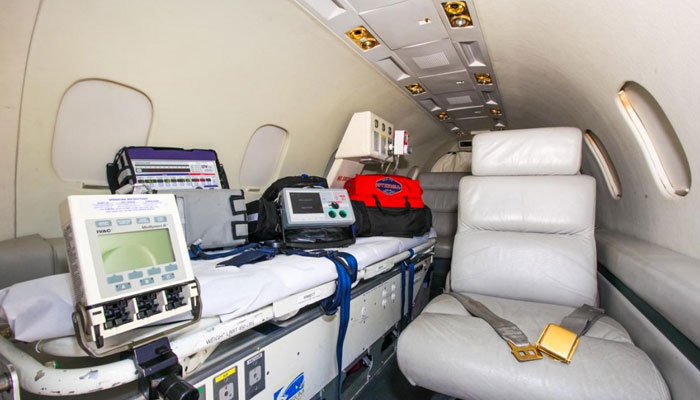History and facts about air ambulances
LAHORE: Former Pakistani premier Nawaz Sharif will depart for the United Kingdom Tuesday aboard an air ambulance, which is a specially equipped aircraft used to transport sick or injured people comfortably and efficiently to hospitals in an emergency.
Related: Return possible only when doctors certify ex-PM is fit to fly
On most occasions, helicopters are used as air ambulances. The British Medical Air Service, which serves customers all over the world, writes on its website: “The equipment inside most air ambulances is the same as you will find in an intensive care ward: one – or, in larger planes – several mobile hospital beds (the stretchers on which patients are transported) and many medical devices, which constantly analyze patients’ vital signs and emit an alarm signal if there is a problem. The equipment in each air ambulance can include everything from breathing apparatus and monitoring systems, pacemakers and defibrillators to blood transfusion equipment and a comprehensive supply of medication.”
The organisation, which claims to have 40 years of expertise in arranging national and international ambulance flights and repatriations, and whose staff speak multiple languages, including English, German, French, Spanish, Italian, Russian, Portuguese, Dutch, Turkish, Polish and four Arabic dialects, adds: “Air ambulances will carry adrenalin, propofol, beta blockers, anti-coagulants (blood thinners), such as heparin, and many other emergency medications. Thanks to the versatile equipment on board air ambulances, we are able to carry ventilated patients safely and at short notice. All medical equipment and medication carried on board is specially selected to fit the needs of the patient who is being transported. In this way, we can always ensure we deliver the best possible medical care to each patient.”
History shows that the first air ambulance service dates back to 1870 during the 17-week long “Siege of Paris” by the invading German forces.
It was the French who first found use for air ambulances in their military endeavours. The air ambulances were not really mechanical. What the French used were air balloons!
However, the use of air transport to provide medical evacuation on the battlefield dates to World War-1, but its role was expanded dramatically during the Korean War (1950-1953) and the Vietnam War (1955-1975).
The first recorded British ambulance flight took place in 1917 in Turkey when a soldier, who had been shot in the ankle, was flown to the nearest hospital in 45 minutes. The same journey by land would have taken some three days to complete.
By the 1920s, France and the United Kingdom were using fully organised air ambulance services during the African and Middle Eastern Colonial Wars. The 1930s saw several private air ambulance companies across the world.
The medical flight industry in the United States employs over 21,000 skilled professionals. The average salary is over $68,000. However, their exemplary services prove useful to over 400 thousand people each year!
It is the ageing population that is driving the worldwide air ambulance industry. For instance, in the United States, the industry is expected to grow at the rate of 10 per cent per annum, mainly owing to an aging population. The global air ambulance industry has more helicopters when compared to airplanes.
-
 Why Claude Is Gaining Momentum In Revolutionizing The AI Landscape
Why Claude Is Gaining Momentum In Revolutionizing The AI Landscape -
 Cheaper Cars, Fewer EVs: Trump Administration Shifts ‘auto Policy’ Focus
Cheaper Cars, Fewer EVs: Trump Administration Shifts ‘auto Policy’ Focus -
 Meghan Markle Takes 'breadwinner' Role In Prince Harry's California Life
Meghan Markle Takes 'breadwinner' Role In Prince Harry's California Life -
 Type 2 Diabetes Hidden Trigger In Daily Food Revealed
Type 2 Diabetes Hidden Trigger In Daily Food Revealed -
 Vertical Tabs Coming To Google Chrome
Vertical Tabs Coming To Google Chrome -
 Jane Seymour Reveals THIS Beloved Romance Was 'worst-reviewed' Movie Ever
Jane Seymour Reveals THIS Beloved Romance Was 'worst-reviewed' Movie Ever -
 European Leaders Slam Trump’s Tariff Threat Over Greenland As ‘unacceptable’
European Leaders Slam Trump’s Tariff Threat Over Greenland As ‘unacceptable’ -
 Princess Eugenie Leaves Father Andrew 'devastated' With Big Step: 't's Brooklyn Beckham Level'
Princess Eugenie Leaves Father Andrew 'devastated' With Big Step: 't's Brooklyn Beckham Level' -
 Nova Scotia Snow Storm Warning Issued As Heavy Snow Moves In
Nova Scotia Snow Storm Warning Issued As Heavy Snow Moves In -
 Vancouver Canucks 2025-26 Season: Adam Foote’s Future Under Early Scrutiny
Vancouver Canucks 2025-26 Season: Adam Foote’s Future Under Early Scrutiny -
 Gabriel Diallo Vs Alexander Zverev: Rising Canadian Eyes Major Upset Opportunity
Gabriel Diallo Vs Alexander Zverev: Rising Canadian Eyes Major Upset Opportunity -
 Bo Nix Injury Update: Broncos Quarterback Fractures Ankle Against Bills
Bo Nix Injury Update: Broncos Quarterback Fractures Ankle Against Bills -
 Oilers Vs Canucks: Why Edmonton Is Without Leon Draisaitl
Oilers Vs Canucks: Why Edmonton Is Without Leon Draisaitl -
 49ers Crushed As Kenneth Walker III Leads Seahawks To 41-6 Win
49ers Crushed As Kenneth Walker III Leads Seahawks To 41-6 Win -
 Canadiens Star Lane Hutson Makes History With 100th NHL Assist
Canadiens Star Lane Hutson Makes History With 100th NHL Assist -
 Bridgerton’s Claudia Jessie Says Her Real-life Style Is Nothing Like Eloise’s
Bridgerton’s Claudia Jessie Says Her Real-life Style Is Nothing Like Eloise’s




